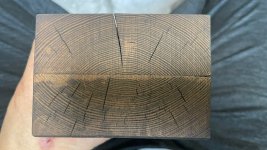JINRO
Member
- Joined
- Dec 8, 2021
- Messages
- 184
So I made a block of wood craft yesterday at garage worshop, brought it in home for stain, let it dry overnight. This morning I found my wood block with tons... and tons of cracks and splits all over.
I live in NY and it has been pretty cold last few days. I do all of cutting, glueing at garage workshop. Staining and finishing at my home office inside.
Only reasone for my wood to go bad so quickly is mosisture difference, but can it make wood fgo bad this quick? Outside humidity is around 35%, inside is around 20%.
Can anyone help me out how to reduce this rapid cracking issue? Does temperature also take much part in this? What's the best/quickest solution to stabilize wood?
I live in NY and it has been pretty cold last few days. I do all of cutting, glueing at garage workshop. Staining and finishing at my home office inside.
Only reasone for my wood to go bad so quickly is mosisture difference, but can it make wood fgo bad this quick? Outside humidity is around 35%, inside is around 20%.
Can anyone help me out how to reduce this rapid cracking issue? Does temperature also take much part in this? What's the best/quickest solution to stabilize wood?


